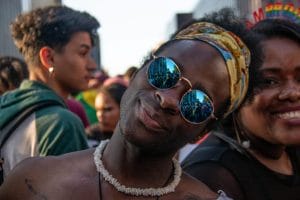Watching this year’s Sydney Gay and Lesbian Mardi Gras on ABC, I found myself reflecting on just how far we’ve come — and how far we still have to go. This event remains a powerful symbol of the resilience, diversity, and solidarity of the LGBTIQA+ community across Australia, from our tiniest country towns to our largest cities.
A Rite of Passage

Some of the commentators spoke about their early recognition of their sexuality — how they’d secretly watch the parade on TV and realise, maybe for the first time: “I’m not the only one.” That feeling of recognition and connection still resonates today, especially for young people or those living in isolation.
Despite growing visibility and inclusion, there is still the problem of heteronormativity or the “heterosexual assumption” — the idea that everyone is straight unless proven otherwise — is still embedded in many aspects of daily life. One striking example is from the 2018 film Love Simon, which cleverly flips the script, highlighting how deeply ingrained these assumptions remain.
For many, attending Mardi Gras is a rite of passage. As musician and actor Troye Sivan once said of his first Pride parade — it was a “life-changing moment.” I imagine for trans people and other LGBTIQA+ people facing increased stigma and marginalisation, events like these can be affirming, joyful, and even life-saving — particularly given the disproportionately high rates of mental health distress and suicidality within the LGBTIQA+ community.
Origins of the Sydney Mardi Gras

The Sydney Mardi Gras has grown from a protest march in 1978 — held in solidarity with the Stonewall riots in New York — into an internationally recognised celebration. It now draws hundreds of thousands of attendees, generates millions for the economy, and shines a global spotlight on our local queer culture.
But we can’t forget its origins. The first march, like Stonewall, was met with police brutality. And echoes of that history remain today — from ongoing mistrust around police participation in Pride events, to the unsolved 1972 murder of Dr George Duncan in Adelaide. (A case widely believed to involve off-duty police officers, yet no one has ever been convicted.)
Dr Duncan’s death did, however, spark change. South Australia became the first state to decriminalise homosexuality — a landmark moment in Australia’s LGBTIQA+ legal history. His story is explored in Tim Reeves’ book The Murder of Dr Duncan, and remains a painful but important chapter in our shared journey.
In Summary
For those curious about the parade’s origins, the 2018 docudrama Riot and the restored 1980 documentary Witches, Faggots, Dykes and Poofters offer powerful insights into the activism, courage, and community that built this movement — and continue to sustain it today.
At its heart, Mardi Gras is more than glitter and sequins. It’s a joyful resistance and a deeply political act — especially at a time when LGBTIQA+ people are still fighting discrimination in faith-based organisations, watching Diversity Equity and Inclusion (DEI) programs face backlash, and seeing books, drag storytimes, and basic rights challenged.
So yes — keep the razzle dazzle. Keep the music, the movement, and the magic alive. Because for those still coming to terms with their identity, or feeling alone in their journey, events like Mardi Gras are more than just a party. They’re proof that there’s a vibrant, loving community ready to welcome them — just as they are. If you want to know more or would like to talk to a professional, my services are always available.




